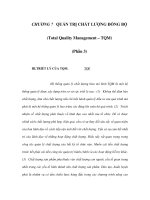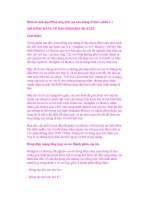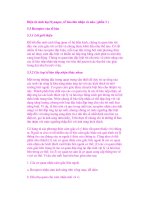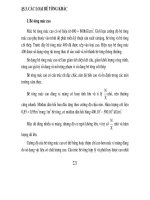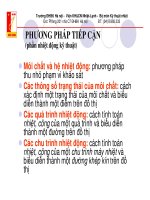Dairy Farm Energy Management Handbook phần 3 ppsx
Bạn đang xem bản rút gọn của tài liệu. Xem và tải ngay bản đầy đủ của tài liệu tại đây (72.72 KB, 8 trang )
Equipment Operation and Maintenance
Ventilation and Fans
Box-type fans and large, low-speed paddle type fans – often called High
Volume Low Speed (HVLS) fans – are the two principle types used for animal
housing.
Box fans are used in conventional tie stall barns or loose housing such as free
stall barns. The HVLS fans are recommended only for loose housing
applications with high side wall heights.
If fans are being used, choose the most efficient
ones available, and make sure they’re equipped
with totally enclosed motors (see section on
Electric Motors). Generally, as fan diameters
increase, the efficiency also goes up.
For example, a standard 48” box fan would
have an average efficiency of 17 cfm/watt, while
a high efficiency 48” box fan would move 20 cfm/watt or more – a 20%
increase in efficiency.
Generally, in dairy free-stall housing, the fans will be operating at 0 inches of
static pressure, according to Kansas State University. In tie-stall or tunnel
ventilated buildings, fans will be operating against 1/10 to 1/4 inches of static
pressure.
To compare fans from different manufacturers, the Bioenvironmental and
Structural Systems Lab (BESS) at the University of Illinois at Urbana-
Champaign conducts standardized tests on fans with accessories and
publishes the test results (Appendix).
Selecting fans for energy efficiency – simply expressed as airflow rate per unit
of input energy, or cfm per watt – is becoming very important. A higher cfm
per watt rating will indicate a more efficient fan.
So, please remember that both fan performance and energy efficiency can
vary widely. A 48” fan can have an efficiency as low as 13 cfm/watt or as high
as 23 cfm/watt at 0.01” static water pressure for the same application. This is
why it’s recommended to review testing information from the BESS.
When comparing fans of different sizes or from different manufacturers, it’s
very useful to study their rated performance data and to find out if the
evaluations have been tested under conditions similar to those in your facility.
(7)
Any increased static pressure caused by operating conditions or accessories
needs to be accounted for in ventilation system design. For example, if your
fan will have shutters and a guard, then evaluate data where the fan was
rated with shutters and guard in place.
This is important because outside shutters reduce airflow and efficiencies by
10 to 25 percent – a very significant loss and one reason why some may
choose not to use them, if deemed appropriate.
With inlet-side shutters, you can expect a 10 to 15% airflow reduction, and
discharge side shutters may result in a 15 to 25% reduction. (7)
Ventilation and Fan Maintenance Tips
Keeping a fan in good repair is as
important in reducing energy costs as
buying the most efficient model. Poor
maintenance can reduce a fan’s
efficiency by 50 % or more. (8)
• Belt adjustment is the single
biggest maintenance problem with
certain types of fans. Belt-driven
fans must be regularly adjusted
through the hot season for full air
movement, so they should be
easy to adjust.
• Loose belts can reduce airflow by as much as 30%. For existing fans,
self-tightening devices can be retrofitted that will take up any slack as
the belt stretches with use and age.
When a new fan or a new belt has been installed, the belt should be
readjusted after two weeks of operation to take up or compensate for
the initial stretch.
• Louvers should shut tightly when a fan is not operating. If they don’t,
heat will escape, and the heater will have to run longer to make up for
the loss. A single louver panel that will not close can waste up to $200 a
year in fuel costs. Improperly working louvers can also reduce output by
as much as 40%.
When the fan is on, louvers must be fully open. Otherwise, they will
restrict the flow of air from the building. A restricted fan operates longer
While High Volume Low Speed (HVLS) fans
are normally recommended for loose housing
applications, they may still be considered for
modern and open free stall facilities. Photo:
Midwest Rural Energy Council
and bears a heavier load to achieve the desired amount of cooling,
which costs more in electricity.
In many cases, you can repair louvers that are sticking (in the open or
closed position) just by cleaning them and applying a dry graphite
lubricant to the hinges. Graphite is recommended over oil because it will
not attract dirt as rapidly and thus reduce the maintenance interval.
Any obstruction on the discharge of a fan impedes airflow. In short, fans
with louvers on the outside are less efficient than comparable fans with
louvers on the inside.
You may have to spend some time shopping to find fans with inside
louvers since most fan louvers are built for installation on the discharge
side.
Louvers also come in two basic types: motor-activated and air-activated.
Air-activated louvers reduce airflow 20% to 30% and are less efficient
because fan power pushes the shutters open.
Motor-activated louvers eliminate that problem because the shutters lift
and close automatically. In addition, motor-activated louvers will work
even when dirty or when the joints get stiff, so cold air is less likely to
enter during wintry days.
• Safety guards should be used on fans within reach of personnel to
prevent accidents. The guard supplied by the manufacturer is usually
best because it lowers fan airflow and efficiency very little (usually by
less than 5%).
• Installing thermostats to control the fans’ on-and-off operation saves
energy and increases productivity.
Research has indicated that dairy cows begin to show heat stress at 74°
F with 70% relative humidity (the average relative humidity for
Wisconsin), so it is recommended that the thermostat be set between
70° F and 75° F.
Sanford recommends using a thermostat designed for outdoors in
damp, dusty conditions. He suggests mounting the thermostats out of
the reach of animals but in an area that will accurately reflect air
temperatures around the livestock.
To ensure accurate readings, the thermostats need to be protected from
direct sunlight and checked, cleaned and perhaps recalibrated monthly
since dust can also affect accuracy.
Equipment Operation and Maintenance
Lighting Efficiently
As was mentioned earlier, lighting can account
from 15% up to about 24% of electricity costs on
a dairy farm. Learning how to use lighting
effectively and efficiently not only can help trim
your utility costs, but it can also improve working
conditions and cow comfort.
In a dairy, you are basically looking at three
major characteristics in lighting-system
performance:
Recommended Illumination Levels for Dairy
Facility Chart
• Light intensity or illumination level:
Illumination levels are measured with a
light meter and expressed in foot-candles
(fc).
In a free-stall, for example, a typical and
recommended illumination level would be
an average of 15 fc, while a holding area
can usually get by with 10 fc. As
reference, a well-lit office usually has a light intensity of 35 to 50 foot
candles.
To help enhance a light’s illumination, especially in outdoor yard lights,
Sanford recommends retrofitting the light with a simple, snap-on full
reflector that replaces the standard refractor.
A refractor, which is a prism-type glass, only directs about 30% of the
full lighting to where it’s really needed.
Color characteristics: Just like sunlight with its various wavelengths that
produce the different colors of a rainbow, artificial lights also produce their
own distinct color spectrum that influence how well objects can be perceived
by the human eye.
A commonly used rating is the Color Rendition Index (CRI), which ranges
from 0 to 100 and indicates the light’s ability to render the true color of an
object. Lights with higher CRI values produce light that renders a truer color,
while lower CRI values produce some color distortion.
Working conditions and cow comfort,
as well as conserving energy, are
greatly improved when lighting fixtures
are used effectively and efficiently.
Photo Karl Ohm
Both the mercury vapor and high-pressure sodium lights have about the same
color rendering index, according to Sanford, but the high-pressure sodium
light is three times more efficient (measured as “lumens per watt”).
A lumen is a unit of measure of light output from a lamp. More specifically one
lumen is equal to the amount of light emitted by one candle that falls on one
square foot of surface located one foot away from one candle.
General Characteristics of Common Light Sources Chart
• Uniformity of light: The ratio of the fixture spacing to the mounting
height determines the “uniformity” of light in a work area.
Understanding this concept is important since mounting heights and the
number of lights mounted in a given space impact the illumination
recommended or required for critical areas in the facility.
Also, it’s important to consider that the light reflectance in dairy barns
usually ranges from 0 to 10% because of the dirty and dusty conditions.
Typically, eliminating the use of incandescent bulbs and mercury vapor
lamps is a successful way to increase lighting efficiency and reduce
energy costs.
• Fluorescents: Fluorescent lights have ballasts that start up the bulbs.
Electronic ballasts are recommended because they are more energy
efficient, generate less heat, have a longer life expectancy, and operate
and start at colder temperatures (0° F) than other ballasts.
Magnetic ballasts are not recommended because they have operating
and starting problems at temperatures of 50°F and below.
Also, if existing fixtures are replaced, then upgrading to nonmetallic
ones is recommended.
• High Intensity Discharge Lights: Metal halide, high-pressure sodium,
and mercury vapor lights are part of a group of long lasting high intensity
discharge (HID) lights that put out large amounts of lumens. They are
used to light large areas.
Metal halide lights put out a fairly white light with CRI values up to 80%.
Their use in dairy facilities is growing.
High-pressure sodium lights put out a gold or yellowish light with CRI
values from 22 to 65% depending on the lamp type.
Lighting professionals in the field report that red is not clearly
distinguishable from brown under low CRI high-pressure sodium lights.
This means that bloody discharges may not be recognizable under high-
pressure sodium lights.
Mercury vapor lights give off a bluish light and have been commonly
used as yard lights; however, they are not recommended for dairy
facilities because of low efficiency, and the CRI values range from 15 to
50%. The bottom line is that you have other and more efficient options
than mercury vapor lights.
• Compact fluorescents: Compact fluorescent lights (CFL) can be used
to replace incandescent lights when the existing fixture meets the
National Electric Code safety requirements for livestock buildings. CFLs
are not very tolerant of high moisture conditions and should be housed
in a water resistant enclosure if used in a farm building. T8 Linear
fluorescent lights provide the best life cycle cost option for new
construction because of higher efficiency and longer bulb life.
In the Recommended Illumination chart, you’ll find a more detailed
breakdown of suggested lighting levels for various areas in a dairy
facility.
• Keep Lights Clean: It usually doesn’t take too long before the normal
airborne dust and dirt in dairy facilities begin clinging to lamp fixtures
and robbing the original intensity of your lighting.
Like a magnet, electrostatic forces within a
light fixture are also at work in attracting
those dirt particles and causing significant
dirt build-up over time.
There’s a fancy term for this dirt build-up on
lights, and some researchers are beginning
to look at ways to put a number on it for
dairy facilities. It’s called Luminaire Dirt Depreciation (LDD). The impact
of flies on lights is also being examined.
While some light manufacturers have data on LDDs for residential,
commercial, and industrial settings, no similar information exists for
dairy facilities. Presently, designers must use data from these
applications and try to match it as best as possible with the environment
in dairy barns.
Researchers at Cornell University and DL Tech, of New York, are doing
field studies at dairy facilities to calculate the specific impact of dust, dirt
and flies on light illumination.
Lighting systems for free-stall barns largely consist of using metal halide
or high-pressure sodium, high-intensity discharge (HID) fixtures. These
lamps don’t “burn-out” like an incandescent bulb. Instead, the light
output depreciates over time.
If a HID lamp is shutting down under power and restriking, this is a sign
that the lamp is at the end of its useful life.
Based on industry information, the recommended relamping schedule
for these fixtures is usually around every 4 - 5 years (the lights are
generally lit only at night and sometimes not the entire night).
These lamps have an expected life of 20,000 - 24,000 hours, and if
they’re on for 12 hours daily (365 days per year), they should last 4 - 5
years.
Also, cleaning dirt and debris off these lamps about every six months is
recommended to maintain good illumination.
• Other basic maintenance points to consider are:
o Inspect sockets, hangers, reflectors and lenses for signs of
corrosion, overheating and any physical damage that could
potentially loosen electrical contacts or lead to moisture and
dust collecting in the fixture.
o Try to avoid intermittent or frequent on/off usage of fluorescent
lamps – a procedure that will shorten lamp life and potentially
damage the ballast.
o When a fluorescent lamp blinks, the lamp should be replaced.
If this does not solve the problem, then the ballast may need to
be replaced. If that doesn’t solve the problem, then you will
need your utility or electrician with specialized tools to
determine the problem source.
